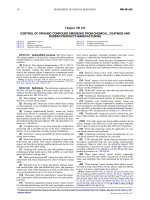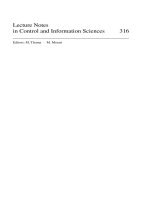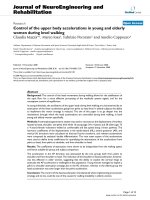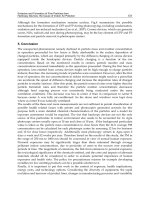Control of Redundant Robot Manipulators - R.V. Patel and F. Shadpey Part 8 potx
Bạn đang xem bản rút gọn của tài liệu. Xem và tải ngay bản đầy đủ của tài liệu tại đây (604.65 KB, 15 trang )
Figure 4.7 General block diagram of the AHIC scheme
In the next simulation, the position of the tip in the X
c
direction is
required to be fixed, while exerting a constant force equal to -100 N in the
Y
c
direction. shows that the main task has been accomplished within a
short time, and from this time onwards, the manipulator does not move
until the MOCA additional task becomes active, and successfully prevents
the coll
isi
on.
Task Compatibility
The objective of this additional task is to position the arm in the posture
which requires minimum torque for a desired force in a certain direction.
The formulation of this additional task is given in Section 2.4.3 .
Figure 4.11 shows the results of the simulation for this case. The main
task consists of keeping the manipulator tip at a fixed position in the X
direction while
exerting -100
N
in
the Y direction. As we
can see
in Figure
4.11b, the manipulator reconfigures itself to find the posture which requires
the minimum torque to exert the desired force. Figure 4.11c shows how the
value of the objective function - task compatibility index given by (2.4.16) -
increases to reach the optimal configuration. Figure 4.11d shows the force
ellipsoid for the initial and final configurations. Note that the force transfer
ratio along the Y
direction has been increased. Figures 4.11e
and
f show
that the force and position trajectories of the main task were followed cor-
rectly. Note that the required torque is reduced when the additional task is
active (Figure 4.11g).
S
x
I-S
x
S
z
I-S
z
( main task )
Task)
T
W
C
T
C
W
X
d
X
·
d
X
··
d
>@
C
F
X
d
>@
C
Z
d
Z
·
d
Z
··
d
T
W
C
1
T
C
1
W
Forward Kinematics
Torque
Kinematic calculations
X
··
t
>@
C
Z
··
t
>@
C 1
Controller
q
··
t
W
·
F
x
e
>@
W
XX
·
>@
W
ZZ
·
F
z
e
F
z
d
CTA
Config.
Control
Computed
CTA (Additional
ARM
&
Force
Se
ns
or
96 4 Contact Force and Compliant Motion Control
4.3
Schemes for
Compliant
and Forc
e
Contr
ol
of Redundant
Manipulators
97
Figure 4.8 Simulation results for the AHIC scheme with Joint Limit
Av
oidance: (a) force error (N
); (b)
position er
ror (mm)
0 0.5 1 1.5 2
-20
0
20
40
60
80
100
___
JLA active
JLA inactive
(q3
min
=-80)
time (s)
(a)
0 0.5 1 1.5 2
-2
-1
0
1
2
3
4
5
x 10
-3
(b)
time (s)
Figure 4.8 (contd.) Simulation results for the AHIC scheme with Joint
Limit Avoidance: (c) joint 3 variable (deg); (d) robot motion - JLA inac-
tive; (e) robot motion - JLA active
0 0.5 1 1.5 2
-
105
-
100
-95
-90
-85
-80
-75
-70
-65
(c)
time (s)
-0.5 0 0.5 1 1.5 2
-
0.5
0
0.5
1
1.5
-0.5 0 0.5 1 1.5 2
-
0.5
0
0.5
1
1.5
init
ia
l
time (s)
time (s)
(d)
(e)
98 4 Contact Force and Compliant Motion Control
4.3
Schemes for
Compliant
and Forc
e
Contr
ol
of Redundant
Manipulators
99
Figure 4.9 Static Obstacle Collision Avoidance: (a) robot motion - SOCA
of
f; (
b)
robot motion - SOCA on; (
c)
position
error (m)
-0.5 0 0.5 1 1.5 2
-
0.5
0
0.5
1
1.5
-0.5 0 0.5 1 1.5 2
-
0.5
0
0.5
1
1.5
0 0.5 1 1.5 2
-
0.5
0
0.5
1
1.5
2
2.5
x 10
-3
time (s)
time (s)
(a)
(b)
time (s)
(c)
Figure 4.9
(contd.) Stati
c Obst
acle Collision Avoidance: (
d) force
error (N)
Force-Controlled Addit
ional Ta
sk
We have already noted that the additional task(s) can be included in
either position-controlled or force-controlled subspaces. In the following
simulation, the additional task consists of exerting a
constant
force
to a sec-
ond compliant surface (Figure 4.12) by an arbitrary point Z on one of the
links - in this simulation, the joint between the second and third links, joint
3. The Jacobian of the additional task is the Jacobian of the point Z, and the
desired force in the Y
c1
direction is to be specified. The main task consists
of
keeping the position of the tip in the
X
w
direction unchanged, while
exerting a constant -100 N force in Y
W
dir
ection on the first constrai
nt sur-
face. The additional task is to exert a 100 N force (in the Y
c1
direction) on
the second constraint s
urface by
joint three. Figure 4.13b
shows
the motion
of the joints and Figures 4.13c, and d show that the main task is executed
correctly. Figure
4.13e shows that the
desired force is exerted on the second
constraint surface. Note that, although initially joint three is not in contact
with the second constraint surface, the AHIC scheme works correctly and
makes this point move toward the surface with a bounded velocity.
0 0.5 1 1.5 2
-20
0
20
40
60
80
100
time (s)
(d)
100 4 Contact Force and Compliant Motion Control
4.3
Schemes for
Compliant
and Forc
e
Contr
ol
of Redundant
Manipulators
101
Figure 4.10 Moving Obstacle Collision Avoidance: (a) robot motion -
MOCA off; (b) robot motion - MOCA on; (c) joint variables (deg);
(d) position error (m).
-0.5 0 0.5 1 1.5 2
-
0.5
0
0.5
1
1.5
-0.5 0 0.5 1 1.5 2
-
0.5
0
0.5
1
1.5
0 0.5 1 1.5 2
-80
-60
-40
-20
0
20
40
60
0 0.5 1 1.5 2
-5
-4
-3
-2
-1
0
1
2
3
4
5
x 10
-4
(b)
time (s)
time (s)
(a)
(c)
(d)
Figure 4.10 (contd.) Moving Obstacle Collision Avoidance:
(e) force error (N)
4.3.3Augmented Hybrid Impedance Control
with Self-Motion Stabilization
As we mentioned earlier, redundancy resolution at the acceleration
level is aimed at minimizing joint accelerations and not controlling the self-
motion of the arm. This is the major shortcoming of the AHIC scheme pro-
posed in Section 4.3.2. In this section by modifying both the inner and outer
control loops, a new AHIC control scheme is proposed which enjoys all the
desirable characteristics of the previous scheme and achieves self-motion
stabilization.
4.3.3.1Outer-Loop Design
The design of the outer-loop is similar to the design in Section 4.3.2.1.
The only difference is that instead of calculating an Augmented Cartesian
Target Acceleration (ACTA) trajectory, we describe the desired motion by
an Augmented Cartesian Target (ACT) trajectory at position, velocity, and
acceleration levels.
The motion of the manipulator in both subspaces can be expressed by a
single matrix equation using the selection matrices S
x
and S
z
, as follows:
0 0.5 1 1.5 2
-20
0
20
40
60
80
100
time (s)
(e)
102 4 Contact Force and Compliant Motion Control
4.3
Schemes for
Compliant
and Forc
e
Contr
ol
of Redundant
Manipulators
103
Figur
e 4.1
1
Ta
sk
compatibility simulation results
-0.5 0 0.5 1 1.5 2
-
0.5
0
0.5
1
1.5
-0.5 0 0.5 1 1.5 2
-
0.5
0
0.5
1
1.5
time (s)
time (s)
-0.5 0 0.5 1 1.5 2 2.5
0
0.5
1
1.5
2
0 0.5 1 1.5 2 2.5 3 3.5 4
-
150
-
100
-50
0
50
100
0 0.5 1 1.5 2 2.5 3 3.5 4
2.6
2.8
3
3.2
3.4
3.6
3.8
0 0.5 1 1.5 2 2.5 3 3.5 4
-2
0
2
4
6
8
10
x 10
-3
0 0.5 1 1.5 2 2.5 3 3.5 4
0
50
100
150
200
250
300
350
400
450
500
(g) Norm of the torque vector
___ TC on
TC off
u
(e) Force error (N)
(f) Position error (m)
(a) TC of
f(
b)
TC on
(c) Task compatibility index (d) Force ellipsoid
Figure 4.12 Force-controlled additional task
(4.3.10)
where the same definitions as in (4.3.5) are used.
The ACT trajectory is the unique solution of the differen-
tial equations (4.3.10) with initial conditions:
(4.3.11)
Notice that the presence of measurement forces in these equations requires
that the ACT trajectory should be generated online.
4.3.3.2Inner-Loop Design
The dynamics of a rigid manipulator are described by equation (4.3.8).
The controller should be designed to calculate the torque input to the
dynamic equation (4.3.8), which ensures the tracking of the ACT trajectory.
The procedure is as follows: First, a Cartesian reference trajectory is
defined for both the main and additional tasks:
X
w
Y
w
X
c
Y
c
T
c
P
c
X
c1
Y
c1
P
c1
T
c1
Z
Contact point with the second
constraint surface
M
x
d
X
··
t
S
x
X
··
d
–B
x
d
X
·
t
S
x
X
·
d
–K
x
d
S
x
X
t
X
d
–
IS
x
–F
x
d
F
x
e
–=–
++
M
z
d
Z
··
t
S
z
Z
··
d
–B
z
d
Z
·
t
S
z
Z
·
d
–K
z
d
S
z
Z
t
Z
d
–
IS
z
–F
Z
d
F
z
e
–=–
++
(a)
(b)
X
t
T
Z
t
T
>@
T
X
t
0 X
d
0 X
·
t
0 X
·
d
0==
Z
t
0 Z
d
0 Z
·
t
0 Z
·
d
0==
104 4 Contact Force and Compliant Motion Control
4.3
Schemes for
Compliant
and Forc
e
Contr
ol
of Redundant
Manipulators
105
Figure 4.13 Force-controlled additional task
(4.3.12)
-0.5 0 0.5 1 1.5 2
-
0.5
0
0.5
1
1.5
0 0.2 0.4 0.6 0.8 1
-80
-60
-40
-20
0
20
40
60
0 0.5 1 1.5 2
-
100
-80
-60
-40
-20
0
20
40
60
0 0.5 1 1.5 2
-60
-40
-20
0
20
40
60
80
100
0 0.5 1 1.5 2
-3
-2
-1
0
1
2
3
4
x 10
-3
initial
final
.
(a)
(b)
(c)
(d
)
(e)
a) Robot motion
b) Joint variables (deg)
c) Position error (m)
d) Main task force (N)
e) Additional task
force error (N)
X
·
r
X
·
t
/
x
XX
t
––= a
X
··
r
X
··
t
/
x
X
·
X
·
t
––= b
Z
·
r
Z
·
t
/
z
ZZ
t
––= c
Z
··
r
Z
··
t
/
z
Z
·
Z
·
t
––= d
where and are positive-definite gain matrices. The joint reference
trajectory is defined by using the task prioritized and singularity robust
redundancy resolution scheme described in Section 4.3.1. This is done by
replacing the Cartesian reference velocity and acceleration in equations
(2.3.19) and (4.3.4) to find . Now a virtual velocity error is defined
as:
(4.3.13)
The control law is then given by:
(4.3.14)
where is a positive-definite matrix. This control law does not cancel the
robot dynamics.
However
, it en
sures asymptotic, or
by
proper choice of
, and , exponential tracking of the ACT trajectory at the same rate as
that of exact cancellation (see [81] and [82]).
Remarks:
• Note that by “asymptotic tracking of
the ACT trajectory”, we
mean that the control law guarantees convergence to a solution
that minimizes (2.3.20).
• The above procedure is different from the design of the controller
in joint space, because in the latter, the ACT trajectory would be
used to generate the desired joint trajectories .
However, in the proposed algorithm, explicit calculation of the
desired joint values is avoided.
• The use of the controller proposed in this section has two major
advantages over the inverse dynamics (or computed torque)
method which is used in Section 4.3.2:
(i) It controls self-motion because both velocity and accel-
eration information are used; the
computed torque
method requires only a commanded acceleration trajec-
tory.
(ii) The
formulation of this algorithm is similar to a non-
adaptive version of the approach of Slotine and Li [81].
/
x
/
z
q
·
r
q
··
r
sq
·
q
·
r
–=
W Hqq
··
r
Cq
q
·
q
·
r
Gq fq
·
K
D
sJ–
e
T
F
x
e
J
c 1
T
F
z
e
–
++++=
K
D
K
D
/
q
d
q
·
d
q
··
d
106 4 Contact Force and Compliant Motion Control
4.3 Schemes for Compliant and Force Control of Redundant Manipulators 107
Therefore, to deal with inaccurate dynamic parameters,
an adaptive implementation of this algorithm can be
developed without major modifications to the inner loop
which is the subject of Section 4.3.4 .
4.3.3.3 Simulation Results for a 3-DOF Planar Arm
The setup for the constrained compliant motion control is shown in Fig-
ure 4.6. A general block diagram of the simulation is shown in Figure 4.14.
Figure 4.14 General block diagram of the AHIC scheme
Obstacle avoidance with
self-motion stabilization
In this simulation, the end-effector is initially at rest and touches the
constraint surface ( f=0 ) at the point (1.5,0). The main task consists of keep-
ing the position in the X direction constant, while exerting a desired -100 N
in the Y direction. There is also a moving object enclosed in a circle in the
workspace. The additional task consists of using the redundant degree of
freedom to avoid this object. The simulation is carried out to compare the
method proposed in Section 4.3.2 and the method proposed in this section.
As we can see in the plot of the joint velocities (Figure 4.15c, Figure
4.16c), there is a movement for a short
period
at the beginning to achieve
the desired force - the end-effector moves in the Y direction to penetrate the
surface. The manipulator remains stationary until the object is close enough
to the arm. The obstacle avoidance task becomes active and makes the
manipulator move in the null space of the Jacobian matrix to avoid collision
S
x
I-S
x
S
z
I-S
z
( ma
in task
)
AC
T
(A
dd
it
io
na
l ta
sk
)
T
W
C
T
C
W
X
d
X
·
d
X
··
d
>@
C
F
X
d
>@
C
Z
d
Z
·
d
Z
··
d
T
W
C
1
T
C 1
W
Fo
rw
ar
d Kine
mat
ics
Ar
m
Kin
em
at
ic ca
lc
ulation
W
·
F
x
e
>@
W
XX
·
>@
W
ZZ
·
F
z
e
F
z
d
&
ACT
Cart.
Ref.
Traj.
Re
dun
d-
X
·
r
X
··
r
Z
·
r
Z
··
r
q
·
r
q
··
r
-
ancy
Resolu-
-tion
Con
tr
ol
Scheme
force
sensor
while satisfying the main task. The two algorithms perform in the same way
up to the point that the object clears the arm. From that point onwards, the
algorithm in Section 4.3.2 is unable to control the null space components of
the joint velocities and causes self-motion (Figure 4.15b). However, the
proposed algorithm is successful in damping out these components and pre-
venting self-motion.
4.3.4Adaptive Augmented Hybrid Impedance Control
It has been shown that control methods that do not address uncertainties
in a manipulator’s dynamics may result in unstable motion in practice. This
has led to considerable work on adaptive control of manipulators [59], [82].
Adaptive compliant control has also been addressed in recent years. Han et
al. [27] have proposed an adaptive control scheme for constrained manipu-
lators based on a nonlinear coordinate transformation; Lu and Meng [41]
have proposed an adaptive impedance control scheme, and Niemeyer and
Slotine [52] have discussed an application of the adaptive algorithm of Slo-
tine and Li [81] to compliant motion control and redundant manipulators.
However, application of the above algorithms to redundant manipulators
introduces several problems. For instance, the algorithm in [27] requires
definition of a nonlinear invertible transformation from joint space to a gen-
eralized task space. The algorithm in [41] is based on the Cartesian
dynamic model of a manipulator and can be applied to the redundant case.
However, no user defined additional tasks can be incorporated in the algo-
rithm and redundancy is based on the generalized inertia-weighted inverse
of the Jacobian. The algorithm proposed in [41] overcomes the above draw-
backs. However, it is assumed that the rows of the Jacobian matrix are lin-
early independent. Hence, it may result in instability near singular
configurations. In this section, by incorporating the adaptive algorithm of
Slotine and Li in the AHIC scheme proposed in Section 4.3.3, an Adaptive
Augmented Hybrid Impedance Control (AAHIC) scheme is presented
which guarantees asymptotic convergence in both position and force con-
trolled subspaces with precise force measurements. The control scheme
ensures stability of the system with bounded force measurement errors.
Even in the case of imprecise force measurement, the errors in the position
controlled subspaces can be reduced considerably provided powerful
enough actuators are available.
4.3.4.1 Outer-Loop Design
The design of the outer-loop is similar to that described in Section
4.3.3.1.
108 4 Contact Force and Compliant Motion Control
4.3
Schemes for
Compliant
and Forc
e
Contr
ol
of Redundant
Manipulators
109
Figure 4.15 Object avoidance without self-motion stabilization
4.3.4.2 Inner-Loop Design
The dynamics of a rigid manipulator are described by equation (4.3.8).
The controller should be designed to calculate the torque input to equation
(4.3.8), which ensures the tracking of the ACT trajectory in the presence of
uncertainties in the manipulator’s dynamic parameters.
It has been shown that for a suitably selected set of dynamic parame-
ters, equation (4.3.8) can be written as:
(4.3.15)
where Y is the regressor matrix and a is the vector of
dynamic parameters. The matrix C is defined in such a way that is
a skew-symmetric matrix [81].
−0.5 0 0.5 1 1.5 2
−0.5
0
0.5
1
1.5
0 0.5 1 1.5 2 2.5
−100
−80
−60
−40
−20
0
20
40
60
0 0.5 1 1.5 2 2.5
−150
−100
−50
0
50
100
150
200
Y
X
(a) Arm motion
(b) Joint values (deg)
(c) Joint velocities(deg/s)
Hqq
··
r
Cq
q
·
q
·
r
Gq fq
·
++
+
Yq
q
·
q
·
r
q
··
r
a=
npu
p
1u
H
·
2 C–
Figure 4.16 Moving object avoidance with self-motion stabilization
Now an extension of the adaptive algorithm of Slotine and Li [81] is
used to design the controller
in order
to ensure asymptotic tracking of the
ACT trajectory. The procedure is as follows:
First, a Cartesian reference trajectory is defined for both the main and
additional tasks (see equations (4.3.12)). Then, a virtual velocity error is
defined (see (4.3.13)). The control law is then given by:
−0.5 0 0.5 1 1.5 2
−0.5
0
0.5
1
1.5
(a) Arm motion
0 0.5 1 1.5 2 2.5
−80
−60
−40
−20
0
20
40
60
0 0.5 1 1.5 2 2.5
−150
−100
−50
0
50
100
150
200
0 0.5 1 1.5 2 2.5
−20
0
20
40
60
80
100
120
0 0.5 1 1.5 2 2.5
−0.01
−0.005
0
0.005
0.01
0.015
0.02
(d) Force
error (N)
(b) Joint values (deg)
(c) Joint velocities (deg/s)
(e) Position error (m)
110 4 Contact Force and Compliant Motion Control









